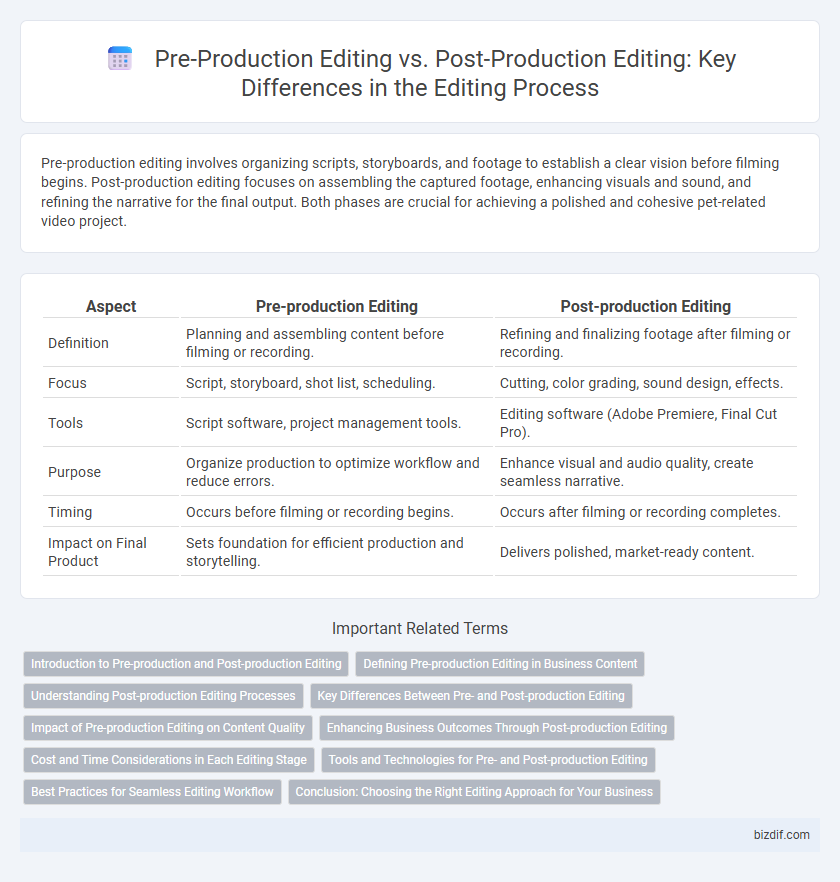Pre-production editing involves organizing scripts, storyboards, and footage to establish a clear vision before filming begins. Post-production editing focuses on assembling the captured footage, enhancing visuals and sound, and refining the narrative for the final output. Both phases are crucial for achieving a polished and cohesive pet-related video project.
Table of Comparison
| Aspect | Pre-production Editing | Post-production Editing |
|---|---|---|
| Definition | Planning and assembling content before filming or recording. | Refining and finalizing footage after filming or recording. |
| Focus | Script, storyboard, shot list, scheduling. | Cutting, color grading, sound design, effects. |
| Tools | Script software, project management tools. | Editing software (Adobe Premiere, Final Cut Pro). |
| Purpose | Organize production to optimize workflow and reduce errors. | Enhance visual and audio quality, create seamless narrative. |
| Timing | Occurs before filming or recording begins. | Occurs after filming or recording completes. |
| Impact on Final Product | Sets foundation for efficient production and storytelling. | Delivers polished, market-ready content. |
Introduction to Pre-production and Post-production Editing
Pre-production editing involves planning and organizing content before filming begins, including script breakdowns and storyboard creation to streamline the shooting process. Post-production editing focuses on assembling, refining, and enhancing raw footage by applying cuts, transitions, color grading, sound design, and visual effects to achieve the final polished product. Both stages are essential for efficient workflow, with pre-production minimizing errors during filming and post-production shaping the narrative and visual style.
Defining Pre-production Editing in Business Content
Pre-production editing in business content involves planning and organizing materials before actual production begins to ensure clarity, consistency, and alignment with strategic goals. This phase includes scriptwriting, storyboarding, and reviewing key messages to optimize communication effectiveness and reduce costly revisions later. Effective pre-production editing streamlines workflows, enhances content quality, and saves time during post-production.
Understanding Post-production Editing Processes
Post-production editing involves refining raw footage through processes like color correction, sound design, and visual effects integration to enhance narrative coherence and visual impact. This phase requires advanced software tools such as Adobe Premiere Pro, DaVinci Resolve, and Avid Media Composer to achieve seamless transitions, synchronize audio, and finalize the film's pacing. Mastery of post-production editing workflows ensures polished, professional-quality video content ready for distribution.
Key Differences Between Pre- and Post-production Editing
Pre-production editing involves planning and organizing raw footage, script revisions, and shot selection to ensure a smooth shooting process, focusing on storyboard creation and scene sequencing. Post-production editing centers on assembling, cutting, color grading, and adding visual effects or sound design to create the final polished product. The key difference lies in timing; pre-production editing shapes the blueprint before filming, while post-production editing refines and enhances the content after the shoot.
Impact of Pre-production Editing on Content Quality
Pre-production editing significantly enhances content quality by establishing a clear narrative structure and identifying potential issues before filming begins. This proactive approach reduces costly reshoots and ensures that the footage captured aligns precisely with the creative vision. Effective storyboarding and script revisions during pre-production result in more cohesive and engaging final edits in post-production.
Enhancing Business Outcomes Through Post-production Editing
Post-production editing refines raw footage with precise color grading, sound design, and visual effects to create a polished final product that resonates with target audiences. This phase enhances storytelling and brand messaging, directly impacting viewer engagement and conversion rates. Leveraging advanced editing software during post-production significantly boosts marketing effectiveness and drives stronger business outcomes.
Cost and Time Considerations in Each Editing Stage
Pre-production editing focuses on planning and organizing content, which reduces costly revisions and accelerates the overall timeline by establishing a clear vision early. Post-production editing demands more time and financial resources due to complex tasks like cutting, color grading, and sound design, often involving multiple iterations and technical adjustments. Efficient pre-production editing lowers post-production expenses and minimizes delays, optimizing the entire project workflow.
Tools and Technologies for Pre- and Post-production Editing
Pre-production editing relies heavily on storyboarding software, scriptwriting tools like Final Draft, and scheduling applications to plan and organize footage efficiently. Post-production editing utilizes advanced video editing programs such as Adobe Premiere Pro, DaVinci Resolve, and Avid Media Composer for color correction, audio mixing, and visual effects integration. Cloud-based collaboration platforms like Frame.io streamline the review and revision process throughout both pre- and post-production stages.
Best Practices for Seamless Editing Workflow
Pre-production editing involves planning the narrative structure, organizing footage, and creating detailed scripts or shot lists to streamline the editing process. Post-production editing focuses on refining the visual and audio elements, such as color correction, sound design, and adding special effects to enhance the final product. Best practices include thorough project organization, consistent communication between teams, and using version control systems to ensure a seamless transition from pre-production planning to post-production execution.
Conclusion: Choosing the Right Editing Approach for Your Business
Pre-production editing streamlines planning by organizing scripts and storyboards, reducing costly revisions during filming, while post-production editing focuses on refining the final content for quality and coherence. Selecting the right editing approach depends on your business goals, budget constraints, and project timeline to maximize efficiency and output quality. Balancing both strategies can enhance workflow, ensuring a polished final product that aligns with your brand's vision.
Pre-production editing vs post-production editing Infographic

 bizdif.com
bizdif.com